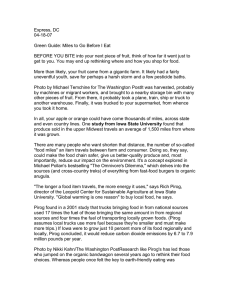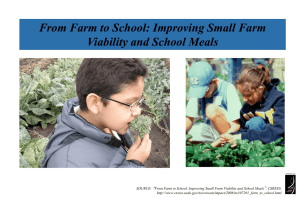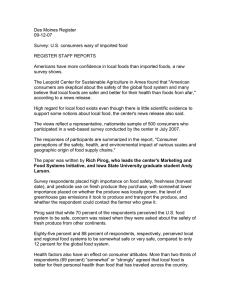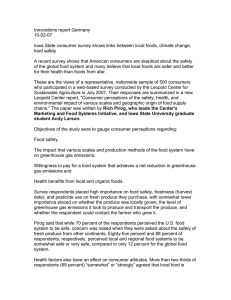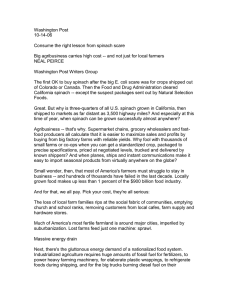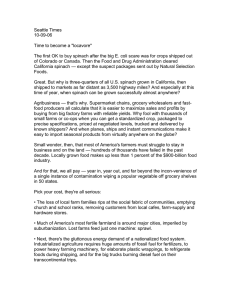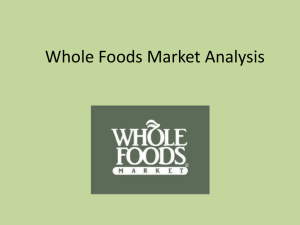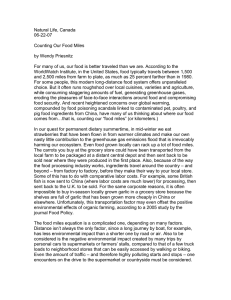Rochester Democrat and Chronicle, NY 09-04-07 Foodies' ideal: Local and organic
advertisement
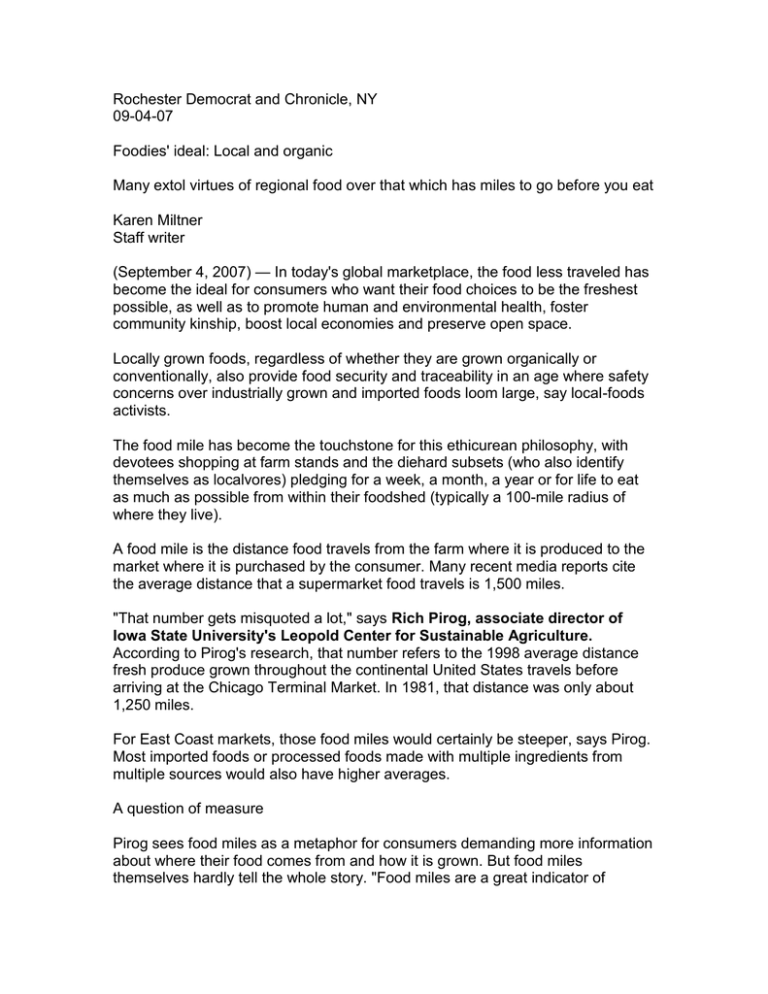
Rochester Democrat and Chronicle, NY 09-04-07 Foodies' ideal: Local and organic Many extol virtues of regional food over that which has miles to go before you eat Karen Miltner Staff writer (September 4, 2007) — In today's global marketplace, the food less traveled has become the ideal for consumers who want their food choices to be the freshest possible, as well as to promote human and environmental health, foster community kinship, boost local economies and preserve open space. Locally grown foods, regardless of whether they are grown organically or conventionally, also provide food security and traceability in an age where safety concerns over industrially grown and imported foods loom large, say local-foods activists. The food mile has become the touchstone for this ethicurean philosophy, with devotees shopping at farm stands and the diehard subsets (who also identify themselves as localvores) pledging for a week, a month, a year or for life to eat as much as possible from within their foodshed (typically a 100-mile radius of where they live). A food mile is the distance food travels from the farm where it is produced to the market where it is purchased by the consumer. Many recent media reports cite the average distance that a supermarket food travels is 1,500 miles. "That number gets misquoted a lot," says Rich Pirog, associate director of Iowa State University's Leopold Center for Sustainable Agriculture. According to Pirog's research, that number refers to the 1998 average distance fresh produce grown throughout the continental United States travels before arriving at the Chicago Terminal Market. In 1981, that distance was only about 1,250 miles. For East Coast markets, those food miles would certainly be steeper, says Pirog. Most imported foods or processed foods made with multiple ingredients from multiple sources would also have higher averages. A question of measure Pirog sees food miles as a metaphor for consumers demanding more information about where their food comes from and how it is grown. But food miles themselves hardly tell the whole story. "Food miles are a great indicator of localness, but they are not a necessarily a good indicator of environmental impact," he says. For example, Idaho potatoes delivered by train to Rochester will burn far less fossil fuel than spuds driven from Maine, as trains are a more energy efficient mode of transportation than trucks. And, as one recent study concluded, it takes a lot more energy for Swedes to grow tomatoes in a greenhouse than it does for them to eat field-grown tomatoes shipped from Spain and then distributed by truck throughout Sweden. "There are folks making claims that local is always better for the environment. We don't have conclusive evidence that that is always the case," says Pirog. Life cycle assessment, which has been used for decades to measure energy efficiency of durable goods, is now being applied to food production. This methodology calculates every environmental impact possible, from fuel expenditure and irrigation to packaging materials and harvesting techniques. All things being equal, the Leopold Center's research in Iowa has found that local and regional food systems have more benefits than drawbacks. A 2006 economic impact analysis concluded that if Iowans ate five servings of Iowagrown fruits and vegetables each day for three months, they could help create nearly 4,100 new jobs — more than all the new ethanol plants have created, Pirog says. The Center's surveys have also shown that for most consumers, the bottom line in buying local is taste and freshness. Helping the local economy and supporting local growers is secondary. How much local and regional food do Americans actually buy? According to the market researcher Packaged Facts, projected local food sales for 2007 are $5 billion, up from $4 billion in 2002. The number of farmers markets is also booming — from 1,755 in 1994 to 4,385 in 2006, according to the U.S. Department of Agriculture. Research by the W.K. Kellogg Foundation, a philanthropic organization, has found that only 1.8 percent of today's national retail food sales are: # Healthful, food that over time won't lead to heart disease, diabetes or other chronic, diet-related diseases. # Green, or grown in a sustainable method, though not necessarily organic. # Fair, produced in a way that does not exploit anyone along the production chain. # Affordable. "Many people are excluded from the Alice Waters feasts or shopping at Whole Foods," says Ricardo Salvador, program director of the foundation's Food Systems and Rural Development. Last year the Kellogg Foundation launched its 2 to 10 strategy, which hopes to boost that margin of healthy, green, fair and affordable foods to 10 percent by 2016. Production and promotion Hank Herrera, managing director of the New York Sustainable Agriculture Working Group, believes that New York (and many other states, for that matter) has the potential to grow and produce 60 percent of the food its residents consume. "The biggest obstacle is the sheer efficiency of the industrial food system. It is so efficient that everyone engaged in it doesn't see any way to change," he says. Small and mid-sized farms that are shut out of the global food chain "need to figure out how to become efficient without sacrificing their values. ... We need to think about making local food more cost efficient. We have to figure out how to make local food affordable to as many people as possible, not just the higher end points of sale." NYSAWG is the New York partner of Buy Fresh, Buy Local, a national campaign to raise awareness of local growers, producers and processors. The campaign provides colorful, attractive marketing materials for its 40 partners nationwide that can be displayed at farm stands, farmers markets and other point-of-sale locations. "It's not a brand, but it acts like a brand in the sense that when you see the logo you know that the person displaying it is a local producer," explains Herrera. Buy Fresh, Buy Local signs are prevalent at the new South Wedge Farmers Market, where market co-founders and managers Chris and Vicki Hartman are encouraging consumers to make a pledge to eat locally during September, designated as Local Food Month. The market is selling "I'm a Rochester Localvore" buttons and is hosting a blog on its Web site (www.swfarmersmarket.org) where participants can share their experiences. "We are not advocating 100 percent local, but in shopping for things that are not local (such as coffee or rice), we hope people will choose products that support someone else's local economy and sustainable farming, such as buying Fair Trade," says Chris Hartman. Indicating eco-status In Europe, the push for labels that address foods' carbon footprint has been going on for years. For example, the Soil Association, the United Kingdom's largest organic certification organization, is debating what to do about airfreighted organic foods. Should they be denied organic status because of air travel's high carbon emissions? Should they be labeled differently? That type of beyond-organic eco-labeling discussion is just starting here in the United States. Elizabeth Henderson, a partner at Peacework Organic Farm in Arcadia, Wayne County, and a longtime organic activist, has been working with a nonprofit initiative called Agricultural Justice Project to create a certification program for organic and sustainable farms that would assure these producers adhere to set criteria regarding workers' rights to collective bargaining, fair wages, fair contracts for farmers and buyers, and workplace health and safety. Agricultural Justice's certification program is currently being tested in the upper Midwest. Next year the project hopes to seek another pilot region in the Northeast, with the Rochester area as a possible candidate. Also of note, says Henderson, is that when Agricultural Justice updates its standards in the next year, food miles, energy usage, biodiversity and humane treatment of animals will likely be included. The Leopold Center's Pirog sees this kind of food production transparency as a good thing for the consumer's food bill of rights. But having the chance to talk directly to the farmer who grew your food makes it a lot easier. "With a farmers market, that information is right there. That is what local food embodies." KMILTNER@DemocratandChronicle.com
